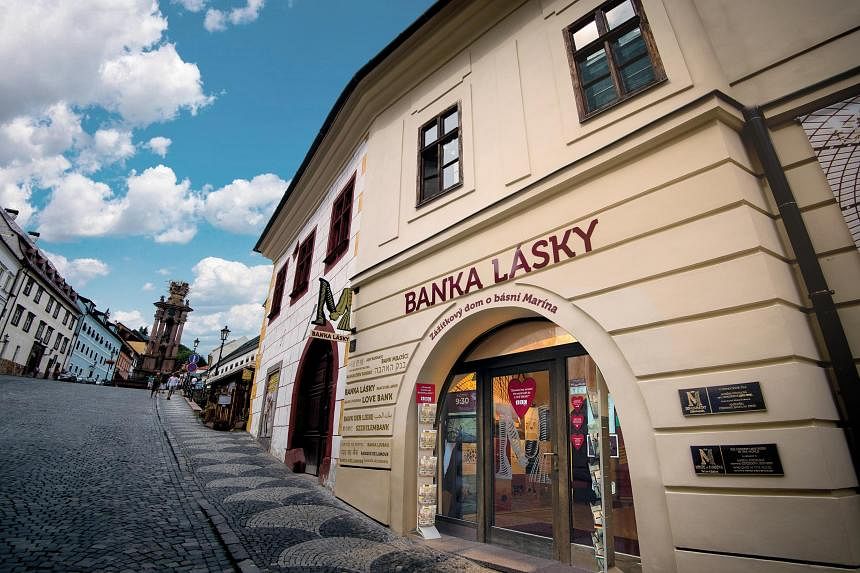BRATISLAVA - For romantics looking to display their passion and devotion, the Love Bank in Slovakia has plenty of room in its Love Vault where 7,000 people have already deposited their keepsakes and symbols of affection, whether reciprocated or unrequited.
But this Valentine’s Day, the bank will be closed.
Its medieval building, once home to the muse for what is called “the world’s longest love poem”, almost burned down in March 2023 – the result, apparently, of an electrical fault, not rapture run amok.
But love proved eternal.
Left intact was the building’s underground vault, where couples and aspiring paramours from around the globe have secreted their totems and messages in tiny Love Boxes.
Also undamaged: the text of the 19th-century love poem that wraps around the walls of the vault like the ivy of infatuation.
The whole idea of a tourist attraction built as a guileless ode to love, and shrine to a Slovak poem, may strike you, at first blush, as defying both rhyme and reason.
But since the Love Bank opened five years ago, tens of thousands have flocked to Banska Stiavnica to reaffirm their devotion in that picturesque town, which was founded in the 13th century and is now a Unesco World Heritage Site.
The original 1846 manuscript for the poem, completed by Andrej Sladkovic after his love, Marina Pischlova, married someone else, is in the Slovak National Library in Martin.
But a facsimile of the work, certified by the World Record Academy as the world’s longest love poem, is on exhibit in the building Pischlova once lived in.
Marina, as the poem is known, consists of 291 stanzas and 2,900 verses. Try fitting that on a Hallmark card.
(Other odes lay claim to being the oldest, and the epic Manas, about the exploits of a Kyrgyz family from Central Asia, appears to be the longest at 500,000 lines.)
While Verona in Italy lures tourists to the balcony from which Shakespeare’s fictional Juliet courted Romeo, Banska Stiavnica draws lovers to the house on Holy Trinity Square where Pischlova once lived with her family.
Sladkovic hailed from poor circumstances. He had to interrupt his education several times to earn a living. During one of those intervals, he was hired as a tutor to the Pischlova family, one of the town’s wealthiest. That was when he met his muse, their daughter Marina.
They fell in love when they were only 14. But if Sladkovic was, as he wrote, incapable of not loving her, he was also incapable of becoming her husband.
While he was off writing or working elsewhere, Marina Pischlova’s parents arranged her marriage to a wealthy gingerbread maker. Sladkovic took two years to complete his poem, too late to win her hand.
The year after she married, Sladkovic was betrothed to a clerk’s daughter; he later married her and became a Lutheran priest.
The founders of the Love Bank, Mr Igor Brossmann and Mr Jan Majsniar, political consultants and partners in a local public relations firm, were inspired one night in 2014 as they passed Pischlova’s grave in the town’s Evangelical Cemetery.
“As we were chatting, it struck us that such a romantic town gave hardly any attention to the love story,” Mr Majsniar said.
“Everything we do,” Mr Brossmann added, “is because we wish that there would be more love in the world. We think that love is the universal answer to the hatred that is so abundant.”
Using Pischlova’s former house as their base, they transformed the abandoned 500-year-old gold mine beneath it into the Love Vault, with 100,000 small, rentable boxes suitable for love tokens, such as photos, a ring, a letter, ticket stubs from a first date, even a flash drive with video of a wedding.
Each box carries a letter, punctuation mark or space from the poem and can be rented for a year at a time for €50 (S$73), or in perpetuity at €100.
In 2021, the Love Bank, a non-profit foundation that seeks to promote the town’s economic development, was nominated for the European Museum of the Year Award, which is bestowed annually by the Council of Europe.
Now the Love Bank and the Old Town, hoping to recover from the fire, are seeking benefactors.
“It has really struck us that the devastating fire, which has damaged the historical centre of our city, happened the year when we are celebrating the 30th anniversary of inscription into Unesco as a World Heritage Site,” Mayor Nadezda Babiakova said.
“Fortunately, the renovation is at full speed. Within two years, the historical centre will be beautiful again.”
Restoration is to begin in February, underwritten by some government funding. But the foundation that operates the Love Bank museum and exhibition and the vault is also soliciting private, corporate and philanthropic contributions.
The house is scheduled to be rebuilt by the end of 2025. If donors can be found, the Love Bank could reopen in time for Valentine’s Day 2027. NYTIMES

